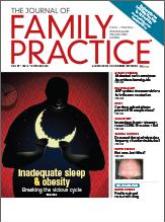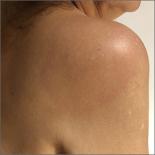Latest News

November 13, 2024
Social Determinants of Health: The Impact on Pediatric Health and Well-Being
November 13, 2024
Yasmeen Abdul-Karim, MD
Yasmeen Abdul-Karim, MD
November 13, 2024
MDedge Family Medicine
November 13, 2024
Survey Study Shows How to Reduce Family Physician Burnout
November 13, 2024
Marcia Frellick
Marcia Frellick
November 13, 2024
MDedge Family Medicine
November 12, 2024
How to Manage Patients on GLP-1s Before Surgery
November 12, 2024
Marilynn Larkin
Marilynn Larkin
November 12, 2024
MDedge Family Medicine
November 12, 2024
Continuous Glucose Monitors for All? Opinions Remain Mixed
November 12, 2024
Marilynn Larkin
Marilynn Larkin
November 12, 2024
MDedge Family Medicine
Family Practice News
50th Anniversary
November 30, 2021
Editor’s note on 50th Anniversary series
November 30, 2021
Katie Lennon
Katie Lennon
November 30, 2021
MDedge Family Medicine

November 19, 2021
Early-in-career family physician shares hopes for future of specialty
November 19, 2021
April Lockley, DO
April Lockley, DO
November 19, 2021
MDedge Family Medicine

November 4, 2021
‘Residents’ Viewpoint’ revisited
November 4, 2021
Katie Lennon
Katie Lennon
November 4, 2021
MDedge Family Medicine

October 25, 2021
My experience as a family medicine resident in 2021
October 25, 2021
Victoria Persampiere, DO
Victoria Persampiere, DO
October 25, 2021
MDedge Family Medicine
Photo Rounds
Enlarging pink patches after traveling
A 69-year-old woman who had recently returned from an East Coast road trip presented with a new rash. She reported extreme fatigue during and after the trip and had developed a low-grade fever.
Ask the Expert
Med Tech Report

November 18, 2021
Medical technology should keep patient in mind
November 18, 2021
Neil Skolnik, MD, et al
Neil Skolnik, MD, et al
November 18, 2021
MDedge Family Medicine

September 23, 2021
Smart watch glucose monitoring on the horizon
September 23, 2021
Neil Skolnik, MD, et al
Neil Skolnik, MD, et al
September 23, 2021
MDedge Family Medicine

August 6, 2021
What is the real risk of smart phones in medicine?
August 6, 2021
Chris Notte, MD, et al
Chris Notte, MD, et al
August 6, 2021
MDedge Family Medicine
Conference Coverage
November 12, 2024
Endometriosis Raises Rates of Postpartum Depression, Other Disorders
November 12, 2024
Brittany Vargas
Brittany Vargas
November 12, 2024
MDedge Family Medicine
November 12, 2024
Barzolvolimab Effective for CSU in Phase 2 Study
November 12, 2024
Liam Davenport
Liam Davenport
November 12, 2024
EADV: European Academy of Dermatology & Venereology
MDedge Family Medicine
November 12, 2024
Children With Severe Atopic Dermatitis Catch Up on Growth With Dupilumab
November 12, 2024
Liam Davenport
Liam Davenport
November 12, 2024
EADV: European Academy of Dermatology & Venereology
MDedge Family Medicine
Coronavirus Updates
November 11, 2024
Pemphigus, Bullous Pemphigoid Risk Increased After COVID-19 Infection
November 11, 2024
Deepa Varma
Deepa Varma
November 11, 2024
MDedge Family Medicine
November 1, 2024
COVID on the Floor Linked to Outbreaks on Two Hospital Wards
November 1, 2024
Fran Lowry
Fran Lowry
November 1, 2024
MDedge Family Medicine
October 22, 2024
How Much Does Long COVID Cost Society? New Data Shed Light
October 22, 2024
David Brzostowicki
David Brzostowicki
October 22, 2024
MDedge Family Medicine
Clinical Inquiries
November 15, 2023
Does taking BP medicine at night (vs morning) result in fewer cardiovascular events?
November 15, 2023
Robert Martin, DO, et al
Robert Martin, DO, et al
November 15, 2023
MDedge Family Medicine
November 13, 2023
Does vaginal estrogen use increase the risk for adverse cardiovascular outcomes?
November 13, 2023
Jacqueline Hendrix, MD, et al
Jacqueline Hendrix, MD, et al
November 13, 2023
MDedge Family Medicine
October 12, 2023
Are manual therapies effective at reducing chronic tension headache frequency in adults?
October 12, 2023
Denver Hager, DO, et al
Denver Hager, DO, et al
October 12, 2023
MDedge Family Medicine
September 12, 2023
Is low-dose naltrexone effective in chronic pain management?
September 12, 2023
Roxanne Radi, MD, MPH, et al
Roxanne Radi, MD, MPH, et al
September 12, 2023
MDedge Family Medicine
Medicine’s Lighter Side
Livin' on the MDedge

June 29, 2023
Placebo effect can be found in a cup of coffee
June 29, 2023
Lucas Franki, et al
Lucas Franki, et al
June 29, 2023
MDedge Family Medicine

June 22, 2023
Low-calorie tastes sweeter with a little salt
June 22, 2023
Lucas Franki, et al
Lucas Franki, et al
June 22, 2023
MDedge Family Medicine

June 15, 2023
The road to weight loss is paved with collusion and sabotage
June 15, 2023
Lucas Franki, et al
Lucas Franki, et al
June 15, 2023
MDedge Family Medicine

June 8, 2023
The enemy of carcinogenic fumes is my friendly begonia
June 8, 2023
Lucas Franki, et al
Lucas Franki, et al
June 8, 2023
MDedge Family Medicine
Perspectives
November 7, 2024
At Last, a Nasal Epinephrine Spray
November 7, 2024
Gary Stadtmauer, MD
Gary Stadtmauer, MD
November 7, 2024
MDedge Family Medicine
November 7, 2024
4 Simple Hacks to Get Paid for Lifestyle Medicine
November 7, 2024
Tamaan K. Osbourne-Roberts, MD, MBA
Tamaan K. Osbourne-Roberts, MD, MBA
November 7, 2024
MDedge Family Medicine

November 6, 2024
Nutrition and Medical Education
November 6, 2024
William G. Wilkoff, MD
William G. Wilkoff, MD
November 6, 2024
MDedge Family Medicine
November 6, 2024
America’s PCPs: Take a Bow
November 6, 2024
Kenneth W. Lin, MD, MPH
Kenneth W. Lin, MD, MPH
November 6, 2024
MDedge Family Medicine
Diversity in Medicine

October 30, 2024
Is Being ‘Manly’ a Threat to a Man’s Health?
October 30, 2024
F. Perry Wilson, MD, MSCE
F. Perry Wilson, MD, MSCE
October 30, 2024
MDedge Family Medicine
October 29, 2024
Can Better Diet Improve Survival in Black Women With Ovarian Cancer?
October 29, 2024
Edited by Katie Lennon
Edited by Katie Lennon
October 29, 2024
MDedge Family Medicine
September 26, 2024
AACR Cancer Progress Report: Big Strides and Big Gaps
September 26, 2024
Sharon Worcester, MA
Sharon Worcester, MA
September 26, 2024
MDedge Family Medicine
September 25, 2024
The Uneven Surge in Diabetes in the United States
September 25, 2024
Manasi Talwadekar
Manasi Talwadekar
September 25, 2024
MDedge Family Medicine
Supplements
April 11, 2024
Pharmacogenomic Testing in Depression Treatment Decision Making: Clinical Pearls for Everyday Practice
April 11, 2024
April 11, 2024
MDedge Family Medicine
March 29, 2024
Dry Eye: A Hands-On Guide for Diagnosis and Treatment in Primary Care
March 29, 2024
March 29, 2024
MDedge Family Medicine
November 15, 2023
Clinical Consult in NASH: Are Your Patients at Risk?
November 15, 2023
November 15, 2023
MDedge Family Medicine
October 12, 2023
Updates in the Management of Erosive Esophagitis
October 12, 2023
October 12, 2023
MDedge Family Medicine
Diabetes
November 12, 2024
Continuous Glucose Monitors for All? Opinions Remain Mixed
November 12, 2024
Marilynn Larkin
Marilynn Larkin
November 12, 2024
MDedge Family Medicine
November 12, 2024
Is Acute Kidney Injury Really a Single Disease?
November 12, 2024
Marilynn Larkin
Marilynn Larkin
November 12, 2024
MDedge Family Medicine

November 12, 2024
‘Round Face’: A Viral Term’s Real Diagnostic Implications
November 12, 2024
Batya Swift Yasgur, MA, LSW
Batya Swift Yasgur, MA, LSW
November 12, 2024
MDedge Family Medicine
November 5, 2024
Patients With IBD More Likely to Develop, or Have Prior, T1D
November 5, 2024
Becky McCall
Becky McCall
November 5, 2024
MDedge Family Medicine




